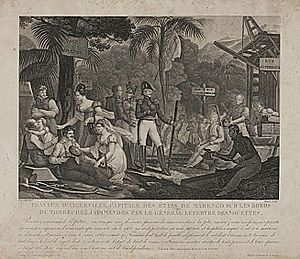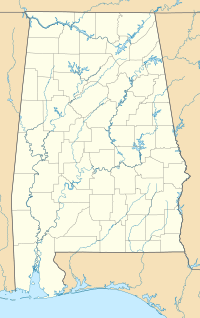Aigleville, Alabama facts for kids
Quick facts for kids
Aigleville, Alabama
|
|
|---|---|

Parisian engraving from 1819 of the building of the Aigleville settlement, directed by General Lefèbvre-Desnoëttes. Note the erroneous inclusion of palm trees, which are not found in central Alabama.
|
|
| Country | United States |
| State | Alabama |
| County | Marengo |
| Elevation | 161 ft (49 m) |
| Time zone | UTC-6 (Central (CST)) |
| • Summer (DST) | UTC-5 (CDT) |
| ZIP code |
36732
|
| Area code(s) | 334 |
Aigleville, which means Eagle Town, was a small settlement in Marengo County, Alabama, United States. It is now a ghost town, meaning it no longer exists as an active community. This town was started in late 1818 by French people who supported Napoleon I (called Bonapartists) and others who had fled from Saint-Domingue (now Haiti). They came to America as part of their plan to grow grapes and olives, known as the Vine and Olive Colony. Aigleville was named after the French Imperial Eagle, a symbol used by Napoleon's army. Today, the area where Aigleville once stood is part of the city of Demopolis.
Contents
The Story of Aigleville
Starting a New Life
The group of French colonists, numbering over 300 people, arrived in Alabama hoping to build a new home. They were part of the Vine and Olive Colony, a special project where the United States government gave them land. Their goal was to grow grapes for wine and olives for oil, just like in France.
In early 1818, they discovered that their first chosen town, Demopolis, was not actually on the land given to them by Congress. So, they moved about one mile (1.6 km) east to a new spot. This new place became Aigleville.
Building the Town
At Aigleville, the colonists built simple log cabins on their town lots. A government official described these homes. They had walls made from hewn logs, which means the logs were shaped flat. Their floors were made of planks or puncheon (split logs). These cabins were about 16 by 18 feet (4.9 by 5.5 m) to 19 by 23 feet (5.8 by 7.0 m) in size.
Land for Everyone
Each settler in Aigleville received three different pieces of land.
- First, they had a town lot where their house was built. These lots were usually 50 by 100 feet (15 by 30 m) to 100 by 200 feet (30 by 61 m).
- Second, they got a garden lot, which was a small piece of land for growing food. These "small allotments" ranged from less than 1 acre (0.40 ha) to 12 acres (4.9 ha).
- Third, they received a farm, called a "large allotment." These farms were much bigger, from 40 acres (16 ha) to 480 acres (190 ha).
Important Colonists
The most important colonists, often military generals or leaders, received the largest farms. Some of these well-known people included General Bertrand Clausel, General Lefèbvre-Desnoëttes, and Joseph Lakanal. Interestingly, some of these men, like the Lallemand brothers, never actually lived in the colony. They stayed elsewhere and eventually sold their land.
The End of Aigleville
The Vine and Olive Colony faced many challenges, and it eventually did not succeed as planned. By the late 1830s, Aigleville was mostly abandoned. Even so, General Lefèbvre-Desnoëttes' house was still standing in 1842.
By the early 1900s, the area where Aigleville once stood was covered in thick forest. Later in the 20th century and into the 21st century, the land was cleared for industrial use by a local cement plant. Today, Aigleville is part of the city of Demopolis and no longer exists as a separate town.
See Also


